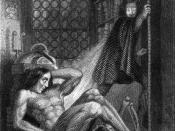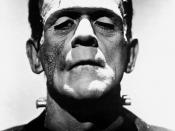Mary Shelley's Frankenstein explores a wide variety of themes, and raises some serious ethical issues. One such issue that comes up time and time again is that of who the real monster is. Is the monster Dr. Victor Frankenstein or is it indeed his dastardly creation? Through a variety of literary devices such as diction, symbolism, and narrative, Shelley delves deeper and deeper into the heart of story and in the end makes it clear just who is the monster and who is the victim.
To separate the monster and the victim it is wise to define the terms, for both terms are quite loosely used in today's society. The term monster is defined by The American Heritage Dictionary as:
"1.a An imaginary or legendary creature, such as a centaur or Harpy, that combines parts from various animal or human forms. b. A creature having a strange or frightening appearance.
2. An animal, a plant, or other organism having structural defects or deformities.
Pathology. 3. A fetus or an infant that is grotesquely abnormal and usually not viable.
A very large animal, plant, or object. 4. One who inspires horror or disgust: a monster of selfishness" (http://dictionary.reference.com/search?q=monster)
The same authority defines victim as:
"1. One who is harmed or killed by another: a victim of a mugging. 2. A living creature slain and offered as a sacrifice during a religious rite. 3. One who is harmed by or made to suffer from an act, circumstance, agency, or condition: victims of war. 4. A person who suffers injury, loss, or death as a result of a voluntary undertaking: You are a victim of your own scheming.
5. A person who is tricked, swindled, or taken advantage of: the victim of a cruel hoax." (http://dictionary.reference.com/search?q=victim).
These definitions alone cannot untangle the case...


